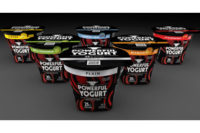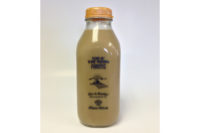
Perspectives From The Top
by Pamela Accetta Smith
Some of the industry’s leading ladies speak out on
their successes and challenges in the ever-evolving dairy processing sector.
There is a noticeable trend
in today’s work force — more women are earning executive
positions in many businesses. It hasn’t been an easy climb, and in
many professions, women are still under-represented at the top. But in the
dairy industry — one long dominated by men — women continue to
make amazing strides with key leadership roles.
Dairy Field sought the
input of women reaching new heights in the industry, from processors to
suppliers to industry associations. The following leaders shared their
views with us:
Connie Tipton, president and chief executive officer,
International Dairy Foods Association (IDFA), Washington, D.C.
Miriam Erickson Brown,
president and chief operating officer, Anderson Erickson Dairy Co., Des
Moines, Iowa.
Rita Duncan, MS, RD, LD,
executive director, St. Louis District Dairy Council., St. Louis.
Sharon Lobel, president and
chief executive officer, Seal-It Inc., Farmingdale, N.Y.
Martha Leyburn, director of
quality assurance and manufacturing technology, Friendly Ice Cream Corp.,
Wilbraham, Mass.
Margaret “Peggy” Poole, Ph.D., vice president of quality and regulatory affairs, HP Hood
LLC, Chelsea, Mass.
Q: What is your specific role in the industry?
Connie Tipton: I am
fortunate to lead the preeminent organization representing dairy foods
companies. IDFA is essentially the staff for the industry in Wash-ington,
D.C., working on regulations and legislation, industry communications,
marketing programs and other activities needed by industry companies. Even
though I’ve been with the industry associations for nearly 25 years,
there were big shoes to fill, as they say, when my husband, Tip, left as
CEO after nearly 40 years of service to the industry. It’s an honor
that industry executives on our boards asked me to lead the organization.
Miriam Erickson Brown: I am
president and COO of an independent family-owned and managed dairy. I have
had the opportunity to serve in a variety of leadership positions in the
industry. I am serving a second term as chair of the Milk Industry
Foundation; I chaired IDFA for one year ending last October, and am now
IDFA secretary/treasurer. I also served on the MilkPEP board in various
capacities for 11 years.
Rita Duncan: Our mission is
to communicate the role and necessity of dairy foods in a healthful diet.
Because few people eat foods that they don’t enjoy, it is
critical that dairy taste great in addition to having nine essential
nutrients.
Sharon Lobel: Seal-It is a
leading manufacturer, converter and printer of heat shrink PVC, PETG and
OPS films that are used for shrink labels and tamper-evident bands. Shrink
labels have become very popular and many dairies are using Seal-It’s
shrink labels for their products. In addition, we also work with food,
health and beauty and industrial manufacturers on their labeling and
tamper-evident needs.
Martha Leyburn: My team
develops programs, materials and training to improve food safety and
quality monitoring of ice cream. On the technology side, we explore,
develop and implement equipment to improve the manufacturing process
through automation.
Peggy Poole: Current
responsibilities include overseeing the quality systems across HP Hood LLC.
This includes the 24 manufacturing facilities with capabilities to produce
conventional dairy products, cultured dairy products, extended shelf-life
and aseptic dairy products. I interact with R&D to assure compliance
with state and federal standards. I maintain and assure compliance with
specifications, nutrition labeling, ingredient declarations, claims and
certifications (kosher, organic, etc). I also oversee the company’s
food safety initiatives.
Q: What motivated you to get involved with the dairy business? What
was your first job in the industry?
Tipton: I had worked in
public relations and fundraising for organizations in Washington, D.C., but
was interested in getting involved in something with more political
interest and substance. The dairy industry association obviously filled the
bill. I started working as part of a 16-person staff for the milk and ice
cream associations in May 1981, doing largely administrative work, but
quickly got involved in sugar policy issues and much, much more. It’s
a great industry to work for and there’s never a lack of issues or
things to do.
Brown: As a
third-generation family owner of Anderson Erickson Dairy, I pretty much
have dairy on the brain. When I began in marketing at AE Dairy, our company
wanted to bring our consumer marketing to the next level, while nationally,
dairy was commonly treated as a commodity. This was a real opportunity for
all kinds of creative thinking, targeted consumer marketing strategies and
product innovation to support the AE brand. My first job was answering the
phone taking product orders — I was 15 years old.
Duncan: My background and
education is in culinary, nutrition and agriculture, which are all
important in working for dairy farmers to promote their products. As a
health care professional (registered dietitian), I often used Dairy Council
materials when I made community presentations. I valued their unbiased
credibility. I believed that they were based on scientific research unlike
materials from some other groups that offered similar materials. When I was
asked to interview for the position of executive director of St. Louis
District Dairy Council, I jumped on it. I thought, what a great job! I get
to promote a healthy, wholesome and nutritious food that tastes great. What
more could you ask for?
Lobel: Seal-It’s
business is to manufacture, convert and print on heat-shrinkable film. When
the dairies turned to single-serve bottles, shrink labels became the label
of choice for these bottles. Right from the beginning, we were called on by
a large dairy to print shrink labels. Seal-It’s quality and fast
turnaround gave us an advantage. We also have extensive print capabilities.
We can print to 10 colors in rotogravure or modified flexographic, and
we also offer digital flexo. We have a clear understanding of how dairies
work, and we have developed programs and methods in order to help dairies
manage their inventory. We communicate with our customers frequently and
they feel comfortable calling with questions. All of these facts contribute
to our success with dairies.
Leyburn: I grew up milking
cows and working on my parents’ dairy farm. With this, going into the
dairy industry seemed to be a natural progression. My first job was in a
large vertically integrated dairy company as a research technician,
developing packaged ice cream flavors and ice cream novelties.
Poole: I’ve always
had personal interests in science, health and nutrition. This led me to
study food science. After completing my Ph.D. in food science-biochemistry
from Rutgers University, I was offered a position with Häagen-Dazs as
a scientist. I held several positions with increasing responsibilities at
Häagen-Dazs, including project manager for R&D, manager of product
development/quality improvement and manager of worldwide
technical/regulatory affairs. What’s not to love about
that? Developing fabulous ice cream products in a fun, cross functional
team-oriented, fast-paced entrepreneurial environment — it was a
great introduction into the dairy business.
Q: In an industry long dominated by men, to what extent do you see
women making strides in leadership roles across the industry? Why do you
think that is?
Tipton: More women are
getting solid educations and more women are pursuing careers, so that
contributes to advancements in many fields. Certainly more women are in
leadership roles here in Washington, D.C., than ever before. We have a few
women on our boards, a change from none not too many years ago. On the
other hand, Betsy Holden chaired the organization and went on to lead
Kraft, so there are certainly possibilities.
Brown: For our industry to
be successfully targeting women as consumers, we need to have their
leadership, in addition to the leadership of men who are sharp enough to
see a need for balance.
Duncan: In many ways, the
dairy industry is no different than many others in its male dominance. Like
other industries, women are making strides to gain leadership roles.
Lobel: I really don’t
feel it matters whether it is a man or woman in a leadership role. Our
customers are interested in price, quality and service. We go out of our
way to make our customers happy. At Seal-It, we strive to give our
customers what they need so that their products become best sellers. I do
feel that women are making strides in the industry, but it is important
that they are not judged as a man or woman but rather what they can
contribute.
Leyburn: Traditional roles
for women in the dairy industry have been in QA, R&D and purchasing.
Now I am starting to see women in engineering roles and a few in
operational roles. I think more opportunities exist because of the number
of young women going to school and graduating as process, industrial and
mechanical engineers.
Poole: Some more
progressive companies recognize the benefit of hiring diverse individuals
(gender, race, work experience, etc). The diversity of the team
strengthens the organization and better positions the company to respond to
changing consumer and customer needs. I do, however, believe that many
corporations have an enhanced understanding of gender and equity issues in
relation to leadership within the
organization. I come across a good number of female senior executives in my
field of work and I do believe that progress has been made toward securing
equal rights for women in the workplace. I think this is probably
attributed to the fact that women make up nearly half of the work force.
Q: As a woman, what do you think you lend to the industry that
perhaps is missed by your male counterparts?
Tipton: I’ve always
thought it important to be measured by accomplishments, not by being a
woman. But I think I have a good balance of skills, including my
“mom” skills, that are helpful in managing a staff and in
leading an industry organization.
Brown: I love it that
women are the primary food purchasers and nutritionists of the household.
As a representation of the target market, I can help fine-tune marketing
messages and set future strategies based on my understanding of the
category and my own experiences.
Duncan: To paraphrase from
a book I just read, “Women Don’t Ask — Negotiation and
the Gender Divide,” women approach negotiation from a collaborative
point of view. They want to make sure they know what everyone wants and
they try to make that happen. Men, on the other hand, are less willing to
disclose information and are more interested in winning than compromise.
Lobel: I believe that
there are many qualified men and women in the industry. Seal-It prides
itself on service. Our customers are the most important part of our
business. We make it as easy as possible for them. If necessary, we hold
their hand and walk them through the process of developing their shrink
label. We try very hard to manufacture a quality product in the least
amount of time and to make sure they are happy. Our No. 1 goal is to make
our customer happy.
Leyburn: Successful women
have the ability to multitask, delegate and prioritize. It is a natural
talent for women to be juggling multiple complex projects all day at work
and then organizing their spouses and children’s lives in their home
at the same time, and doing it well.
Poole: I believe that men
and women are equally capable and have similar skill sets. I believe that
the differences really lie at the individual level (having differences in
perspectives, experiences, educational backgrounds, etc). For instance, as
an individual, I bring to the industry a mix of
work experiences and life experiences. I have worked in R&D and QA for
both large corporations and small entrepreneurial companies. I have a very
supportive family (husband and two children) and have lived in several
states in the U.S. I have over 20 years of successful dairy product
development experiences.
Q: Do you see more women in dairy in the future?
Tipton: I’m sure the
numbers of women working in our industry in leadership roles will continue
to increase. There are a lot of talented men and women who contribute to
the industry’s growth, innovation and success.
Brown: Absolutely! I think
as a result of MilkPEP, processors are beginning to see the need for
marketing support for their products, creating new positions and growth.
Dairy has a squeaky-clean foundation that most other industries would kill
to have. The opportunity to be involved with a family-oriented, high-usage
retail category like dairy is exciting for males and females.
Duncan: I think that as
more women join the executive ranks they will be valued for their ability
to resolve difficult situations with win-win outcomes.
Lobel: I see more women
entering the packaging industry both in dairy and other fields. My feeling
is that what’s important to our customer is providing them with a
good product at a competitive price. I hope to see highly qualified people
of both genders enter the dairy business.
Leyburn: Yes, as
manufacturers become more lean structurally, women will be given the
opportunity to take on more responsibilities and will therefore cross into
areas that are typically male-dominated roles.
Poole: YES — and I welcome it!
$OMN_arttitle="Perspectives From The Top";?>

